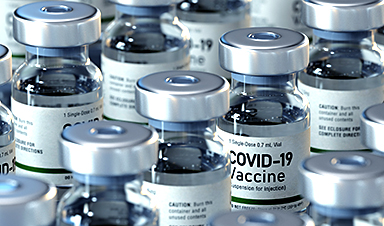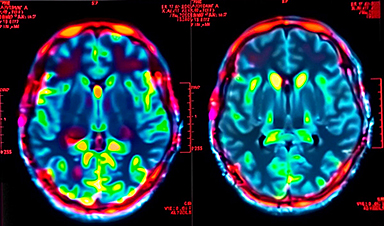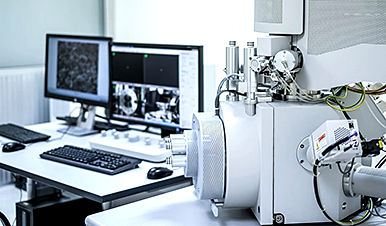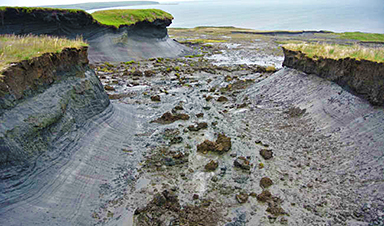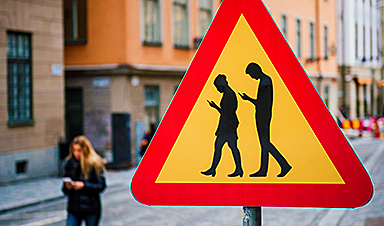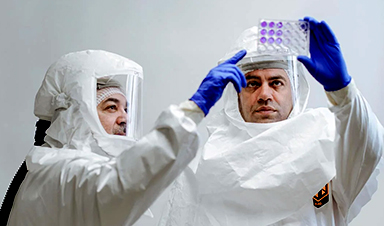Breakthrough infections are exceedingly rare. But by tracking them, researchers can uncover viral variants that manage to dodge the immune response.
Tens of millions of people in the United States have now been fully vaccinated against covid-19. These people are seeing friends, eating out, and—in rare cases—getting infected.
But we shouldn’t panic: these kinds of “breakthrough infections” are entirely expected with any mass vaccine rollout.
According to new figures released by the Centers for Disease Control and Prevention, more than 87 million people had been vaccinated in the US as of April 20. Of those, 7,157—0.008%—went on to become infected with SARS-CoV-2. The true number is likely to be slightly higher because mild or asymptomatic infections might be missed or go unreported. But the data are still encouraging. Only a tiny fraction of vaccinated people became infected and an even tinier fraction developed serious illness: just 331 were hospitalized for covid-19, and 77 died of the disease.
New studies published last week show that even in high-risk settings like nursing homes, these breakthrough infections seem to be rare. And when infections do occur, symptoms tend to be nonexistent or mild. What’s more, vaccinated individuals who become infected have lower viral loads than unvaccinated people—meaning they are less likely to transmit the virus.
Still, it’s important to keep monitoring breakthrough infections. All the existing covid-19 vaccines prime the immune system to recognize the spike proteins on the virus’s surface so that when the system encounters the real pathogen, it can fight back quickly. But if the body doesn’t mount a strong immune response to the shot, it won’t be ready to fight the virus. In other cases, the pathogen may have evolved enough to evade the body’s prepared immune response, and the vaccine won’t work as well. This is called immune escape.
Some researchers studying SARS-CoV-2 worry that with so much virus still circulating globally, the virus will have plenty of chances to hit on a winning combination of mutations that allow it to evade the immune response prompted by the vaccine. Tracking breakthrough infections could help them spot worrisome new variants and identify when vaccines are becoming less effective. This might help determine when booster shots are needed or point to more effective vaccine designs.
High-risk environments
People who work and live in nursing homes were among the first to be offered the covid-19 vaccine, and some of the first to benefit. Between late December and late March, case numbers in these facilities dropped by 96%. Nursing homes are ideal places for pathogens to spread and cause harm, and vaccines may not work as well because older people’s bodies typically mount a weaker immune response. Even influenza outbreaks can be deadly in these facilities. But the CDC found few breakthrough covid infections.
In one study, researchers analyzed infections in 78 Chicago nursing homes with nearly 8,000 vaccinated residents and 7,000 vaccinated staff. They found more than 600 coronavirus infections, but only 22 of those occurred in fully vaccinated individuals, 12 in residents and 10 in staff. Fourteen were asymptomatic and five caused only mild symptoms. When the team examined specimens from seven of the people with breakthrough infections, they found low levels of the virus. And none of the initial infections led to additional cases, suggesting that these vaccinated people didn’t spread the virus.
And when outbreaks do occur, the vaccines still provide good protection. A second CDC study examined an outbreak in a Kentucky nursing home where just half the staff were fully vaccinated. The outbreak, which began with an unvaccinated staff member, led to 46 covid-19 infections. Out of 71 vaccinated residents, 18 (25%) became infected, two were hospitalized, and one died. The staff fared better. Of the 56 vaccinated employees, four (7%) became infected. Most of those infections were asymptomatic. Only 6.3% of the residents and staff who had been vaccinated developed symptoms, compared with 32% of unvaccinated individuals.
During a nursing home outbreak, “staff and residents are continuously encountering the SARS-CoV-2 pathogen over and over again,” says Meagan Fitzpatrick, who models infectious diseases at the University of Maryland School of Medicine. So seeing such a small number of infections in this type of setting is encouraging
Image Credit: Envato / Amanda Scott
Post by Amanda Scott, NA CEO. Follow her on twitter @tantriclens
Thanks to Heinz V. Hoenen. Follow him on twitter: @HeinzVHoenen
News
Does COVID increase the risk of Alzheimer’s disease?
Scientists discover that even mild COVID-19 can alter brain proteins linked to Alzheimer’s disease, potentially increasing dementia risk—raising urgent public health concerns. A recent study published in the journal Nature Medicine investigated whether both mild and [...]
New MRI Study Reveals How Cannabis Alters Brain Activity and Weakens Memory
A massive new study sheds light on how cannabis affects the brain, particularly during cognitive tasks. Researchers analyzed over 1,000 young adults and found that both heavy lifetime use and recent cannabis consumption significantly reduced brain [...]
How to Assess Nanotoxicity: Key Methods and Protocols
With their high surface area and enhanced physicochemical properties, nanomaterials play a critical role in drug delivery, consumer products, and environmental technologies. However, their nanoscale dimensions enable interactions with cellular components in complex and [...]
Nanotech drug delivery shows lasting benefits, reducing need for repeat surgeries
A nanotechnology-based drug delivery system developed at UVA Health to save patients from repeated surgeries has proved to have unexpectedly long-lasting benefits in lab tests – a promising sign for its potential to help human patients. [...]
Scientists Just Found DNA’s Building Blocks in Asteroid Bennu – Could This Explain Life’s Origins?
Japanese scientists detected all five nucleobases — building blocks of DNA and RNA — in samples returned from asteroid Bennu by NASA’s OSIRIS-REx mission. NASA’s OSIRIS-REx mission brought back 121.6 grams of asteroid Bennu, unveiling nitrogen-rich organic matter, including DNA’s essential [...]
AI-Designed Proteins – Unlike Any Found in Nature – Revolutionize Snakebite Treatment
Scientists have pioneered a groundbreaking method to combat snake venom using newly designed proteins, offering hope for more effective, accessible, and affordable antivenom solutions. By utilizing advanced computational techniques and deep learning, this innovative [...]
New nanosystem offers hope for improved diagnosis and treatment of tongue cancer
A pioneering study has unveiled the Au-HN-1 nanosystem, a cutting-edge approach that promises to transform the diagnosis and treatment of tongue squamous cell carcinoma (TSCC). By harnessing gold nanoparticles coupled with the HN-1 peptide, [...]
Global Trust in Science Is Stronger Than Expected – What’s Next?
A landmark global survey conducted across 68 countries has found that public trust in scientists remains robust, with significant support for their active involvement in societal and political matters. The study highlights the public’s [...]
Microplastics in the bloodstream may pose hidden risks to brain health
In a recent study published in the journal Science Advances, researchers investigated the impact of microplastics on blood flow and neurobehavioral functions in mice. Using advanced imaging techniques, they observed that microplastics obstruct cerebral blood [...]
AI Surveillance: New Study Exposes Hidden Risks to Your Privacy
A new mathematical model enhances the evaluation of AI identification risks, offering a scalable solution to balance technological benefits with privacy protection. AI tools are increasingly used to track and monitor people both online [...]
Permafrost Thaw: Unleashing Ancient Pathogens and Greenhouse Gases
Permafrost is a fascinating yet alarming natural phenomenon. It refers to ground that remains frozen for at least two consecutive years. Mostly found in polar regions like Siberia, Alaska, and Canada, permafrost plays a [...]
Frequent social media use tied to higher levels of irritability
A survey led by researchers from the Center for Quantitative Health at Massachusetts General Hospital and Harvard Medical School has analyzed the association between self-reported social media use and irritability among US adults. Frequent [...]
Australian oysters’ blood could hold key to fighting drug-resistant superbugs
Protein found in Sydney rock oysters’ haemolymph can kill bacteria and boost some antibiotics’ effectiveness, scientists discover An antimicrobial protein found in the blood of an Australian oyster could help in the fight against [...]
First U.S. H5N1 Death Sparks Urgency: Scientists Warn Bird Flu Is Mutating Faster Than Expected
A human strain of H5N1 bird flu isolated in Texas shows mutations enabling better replication in human cells and causing more severe disease in mice compared to a bovine strain. While the virus isn’t [...]
AI Breakthrough in Nanotechnology Shatters Limits of Precision
At TU Graz, a pioneering research group is leveraging artificial intelligence to drastically enhance the way nanostructures are constructed. They aim to develop a self-learning AI system that can autonomously position molecules with unprecedented precision, potentially [...]
How Missing Sleep Lets Bad Memories Haunt Your Mind
Research reveals that a lack of sleep can hinder the brain’s ability to suppress unwanted memories and intrusive thoughts, emphasizing the importance of restful sleep for mental health. Sleep deprivation has been found to [...]
